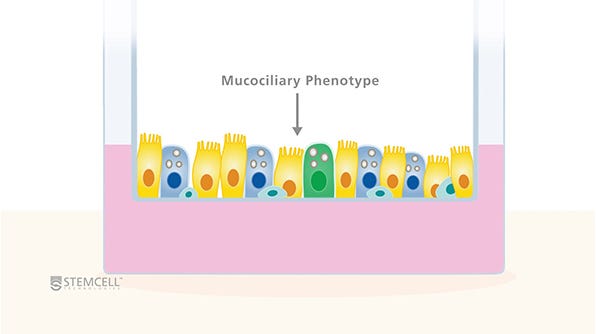Airway Modeling
Physiologically relevant in vitro lung models that closely resemble the in vivo human airway are critical for enabling pulmonary research. Therefore specialized cell culture techniques have been developed to recapitulate the morphological and functional characteristics of the pseudostratified epithelium, at the air-liquid interface (ALI) or as airway organoids. This has expanded the range of applications and relevance of in vitro culture systems.
Below is a collection of resources to help with your airway modeling for pulmonary research.
How to Model the Human Airway at the Air-Liquid Interface
Primary human bronchial epithelial cells (HBECs) can be expanded and differentiated into a pseudostratified mucociliary epithelium that closely mimics what is observed in vivo. Watch this protocol video to learn more.
Watch Now >-
 How to Prepare Conditioned Medium for the Expansion of Epithelial Cells<meta property="og:title" content="How to Prepare Conditioned Medium for Expansion of Epithelial Cells"/> <meta property="og:description" content="Learn how to generate conditioned medium from 3T3-J2 Irradiated Feeder Cells and Conditional Reprogramming Medium."/> <meta property="og:image" content="https://cdn.stemcell.com/media/images/social/propagenix-cm-protocol.png"/> <meta name="twitter:card" content="summary_large_image"/> <meta name="twitter:site" content="@ŗŚĮĻ³Ō¹ĻTech"/> <meta name="twitter:image" content="https://cdn.stemcell.com/media/images/social/propagenix-cm-protocol.png"/>
How to Prepare Conditioned Medium for the Expansion of Epithelial Cells<meta property="og:title" content="How to Prepare Conditioned Medium for Expansion of Epithelial Cells"/> <meta property="og:description" content="Learn how to generate conditioned medium from 3T3-J2 Irradiated Feeder Cells and Conditional Reprogramming Medium."/> <meta property="og:image" content="https://cdn.stemcell.com/media/images/social/propagenix-cm-protocol.png"/> <meta name="twitter:card" content="summary_large_image"/> <meta name="twitter:site" content="@ŗŚĮĻ³Ō¹ĻTech"/> <meta name="twitter:image" content="https://cdn.stemcell.com/media/images/social/propagenix-cm-protocol.png"/> -
 How to Perform a TEER Measurement to Evaluate Epithelial Barrier Integrity in ALI CulturesLearn how to perform a transepithelial electrical resistance (TEER) measurement to evaluate the barrier integrity of epithelial cells in an air-liquid interface (ALI) culture
How to Perform a TEER Measurement to Evaluate Epithelial Barrier Integrity in ALI CulturesLearn how to perform a transepithelial electrical resistance (TEER) measurement to evaluate the barrier integrity of epithelial cells in an air-liquid interface (ALI) culture -
 Studying Cystic Fibrosis Using Primary Human Nasal Epithelial CellsCystic Fibrosis (CF) is a genetic disease that affects multiple organs in the body. The primary defects are in the airway and related to epithelial dysfunction. Technological advances have enabled researchers to study CF using specialized in vitro cell culture models to recapitulate the pseudostratified airway epithelium. In this webinar, Dr. Theo Moraes elaborates on the advantages of using nasal epithelial cell cultures to perform such studies and their implications for precision medicine in CF. He also discusses the Program for Individualized Cystic Fibrosis Therapy (CFIT)ā€”a collaboration between CF Canada, SickKids Foundation, and The Hospital for Sick Childrenā€”and how it utilizes the nasal culture methodology to develop a nationally accessible resource and to accelerate the development of individualized therapies for CF patients. <br><br> Dr. Theo Moraes is a clinician and researcher at The Hospital for Sick Children and the SickKids Research Institute in Toronto, Canada.
Studying Cystic Fibrosis Using Primary Human Nasal Epithelial CellsCystic Fibrosis (CF) is a genetic disease that affects multiple organs in the body. The primary defects are in the airway and related to epithelial dysfunction. Technological advances have enabled researchers to study CF using specialized in vitro cell culture models to recapitulate the pseudostratified airway epithelium. In this webinar, Dr. Theo Moraes elaborates on the advantages of using nasal epithelial cell cultures to perform such studies and their implications for precision medicine in CF. He also discusses the Program for Individualized Cystic Fibrosis Therapy (CFIT)ā€”a collaboration between CF Canada, SickKids Foundation, and The Hospital for Sick Childrenā€”and how it utilizes the nasal culture methodology to develop a nationally accessible resource and to accelerate the development of individualized therapies for CF patients. <br><br> Dr. Theo Moraes is a clinician and researcher at The Hospital for Sick Children and the SickKids Research Institute in Toronto, Canada. -
 Cellular Organization and Biology of the Respiratory SystemOverview of the organization and function of different parts of the respiratory system
Cellular Organization and Biology of the Respiratory SystemOverview of the organization and function of different parts of the respiratory system -
 How to Model the Human Airway at the Air-Liquid Interface: Expansion of HBECsLearn how to expand human bronchial epithelial cells (HBECs) to initiate an air-liquid interface (ALI) culture using PneumaCultā„¢ culture media
How to Model the Human Airway at the Air-Liquid Interface: Expansion of HBECsLearn how to expand human bronchial epithelial cells (HBECs) to initiate an air-liquid interface (ALI) culture using PneumaCultā„¢ culture media -
 How to Perform Immunocytochemistry (ICC) Staining of Epithelial Cells Cultured as Monolayers or at the Air-Liquid InterfaceHow to perform immunocytochemistry (ICC) staining of air-liquid interface or monolayer cultures in your own lab
How to Perform Immunocytochemistry (ICC) Staining of Epithelial Cells Cultured as Monolayers or at the Air-Liquid InterfaceHow to perform immunocytochemistry (ICC) staining of air-liquid interface or monolayer cultures in your own lab







